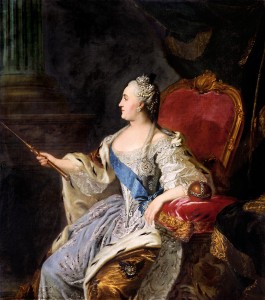
Portrait of Catherine II (1763)
In the article Catherine the Great and the Problem of Female Rule, Brenda Meehan-Waters argues that Western European writers and Russian writers view the reign of Catherine the Great differently, and that these views reveal cultural reactions towards women in positions of power. Western foreigner ambassadors and correspondents alike of Catherine II almost always bring into discussion the fact that she is a women and the traits that differentiate men and women. Foreigners describe her as having “a masculine force of mind” with a “weakness vulgarity attributed to her sex” and as “an ambitious and unnatural women” giving the impression that “there was something inherently perverse in female ambition”. ((KM 380 – 382)) In general, the authors states that Westerners who felt threatened by the idea of a women ruler responded either by denying that Catherine held any real power or they exaggerated her negative qualities, therefore making her sound less qualified.
Russians, on the other hand, rarely brought up the fact that she was a women. There are two exceptions to this that the author brings up. Karamzin contrasts the masculinity and femininity of Peter the Great and Catherine the Great and states that their reign complements the other but also attributes masculine traits as positive and negative traits as feminine. Sumarokov too has similar viewpoints articulates that there are strong and weak rulers and Catherine falls in between the two. ((KM 380-381)) In general though, Russians rarely focus on her femininity. The author points out that there was no ideological battle on female rule in Russia as there was in Western Europe, adding evidence that the sex of the ruler was less important to Russians. In fact, Russian empresses are often found in poetry as viewed as great warriors and strong figures. Another reason as to why the Russians view Catherine’s reign more positively is the old Byzantine idea of a hermaphroditic being that united the principles of both sexes. ((KM 384))
At the very end, Meehan-Waters points out that we more often study the reasons why Russians don’t judge her based on sex, and not why Europeans do judge her in this way and that this take on it is backwards.
Question:
Why do you think we assume that the Russian’s acceptance of a female is abnormal? How can this be explained by referring to leading Western thinkers?
https://upload.wikimedia.org/wikipedia/commons/0/06/Profile_portrait_of_Catherine_II_by_Fedor_Rokotov_(1763,_Tretyakov_gallery).jpg
